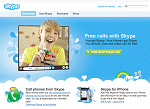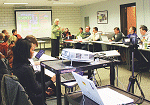21st Century Teaching
Which Came First - The Technology or the Pedagogy?
- By Dian Schaffhauser
- 09/09/09
A new spin on an old riddle goes to the heart of a
conflict between K-12 schools and the colleges of
education responsible for cultivating and providing
them with new teachers.
 WHY IS A GENERATION of teachers more
knowledgeable about technology than any
before it arriving in classrooms with little
understanding of how to teach with it?
WHY IS A GENERATION of teachers more
knowledgeable about technology than any
before it arriving in classrooms with little
understanding of how to teach with it?
It's a debate that, according to Ann
Thompson, director of Iowa State University's
Center for Technology in Learning and
Teaching, has K-12 and higher ed engaged in
mutual finger-pointing. "School districts
say, 'If colleges of education just better prepared
new teachers in technology, we'd be
all set, but they're not doing their job,'"
Thompson says. "Colleges of education say,
'We're doing a great job, but then students
go out into schools and they don't have
access to technology or don't see other
teachers using technology, so some of this
prep goes to waste.'"
Thompson believes that on their end, colleges of education
can help cross that chasm by instilling in preservice teachers
a sense of humility for their first year or two in the classroom
and deference for veteran faculty members. "It's important
that they understand that they may bring a lot of technical
expertise, but that they have a lot to learn from the [other]
teachers in schools in terms of pedagogy and content," she
says. Thompson also concedes that higher ed has been guilty
of paying too much attention to the devices themselves. "We
all did at first: 'If we just teach teachers how to use technology,
they'll figure out how to teach with it.' Although it was an
understandable approach, it really wasn't the approach we
should be taking."
Glen Bull, co-director of the Curry School of Education
Center for Technology and Teacher Education at the University
of Virginia, is more blunt. "A Smart Board doesn't teach
anything," he says, noting that at his institution, knowing how
to operate a device is a baby step toward understanding tech
integration. "Five years of prep are what we think are needed
to take advantage of it."
Tying Technology to Topic
The five years of prep Bull refers to is the Curry School's fiveyear
program that integrates subject-matter education with
teaching expertise, coordinating students' undergraduate and
graduate work. The student's undergraduate major is matched by
that same area of concentration in the education program. With
the help of academic advisers on both ends, preservice math
majors, for example, will focus their education studies on math
teaching. At the end of the five years, students receive from the
university both a bachelor's degree in the given subject matter
and a Master of Teaching degree. The program has since evolved
to include technology as a content area.
Integrating Online Technologies
 AT WAYNE STATE UNIVERSITY IN DETROIT, Mary Brady, a senior lecturer in
special education and instructional technology in the school's College of
Education, believes the drift toward student-oriented online learning obligates
teachers to become engaged firsthand in web-based technologies if they are
going to be able to deliver their educational uses.
AT WAYNE STATE UNIVERSITY IN DETROIT, Mary Brady, a senior lecturer in
special education and instructional technology in the school's College of
Education, believes the drift toward student-oriented online learning obligates
teachers to become engaged firsthand in web-based technologies if they are
going to be able to deliver their educational uses.
"In the state of Michigan, every high school student must have at least
one online class experience for graduation," Brady says. "What I say to
my students is, 'How can we have that as a high school requirement if
we've never walked in their shoes?' We have to take an online class to
be in a better position to train our students so they'll be ready for that
online experience."
Read about
the Florida Virtual School’s new effort to teach local
preservice teachers how to deliver classes online.
For that reason, Brady teaches her courses online. She meets students
face-to-face for the first night of class to introduce the use of the college's
learning management system, from Blackboard.
Students must then use
the LMS to create their
own web page.
Next, they sign up for a Skype account. Brady makes herself
available for student
meetings through the IPbased
phone service. She
also relies on TechSmith's Camtasia Studio, a tool that can capture
computer-based demonstrations with audio for playback. When one of her
students doesn't understand how to perform a particular software-based or
online activity, Brady will create a recording in which she demonstrates the
activity, and then send it off.
The university holds an annual conference in February, where new teachers
return to the school to share how their technology training has played out
for them. Brady says that some of them have reported using Skype to set up
scheduled times to be available to talk with parents, and others use Camtasia
to record lessons for students who are absent or who need further review.
Brady has just begun dabbling with the microblogging service Twitter, to send out quick alerts to her students, for example.
Although she hasn't had reports back yet from any of her newly certified
classroom teachers, she expects to hear that they're doing the same with
their students as well as parents-- reminding them about deadlines and
getting the word out about special events.
"The formal expression of this is 'technological pedagogical
content knowledge (TPACK),'" Bull says. "TPACK says that you
have to know three things to use technology well. You first have
to know the content. It's going to be hard to teach calculus if you
don't know calculus yourself. You also need to know
the pedagogy associated with that content-- the instructional
strategies that will be effective. Finally, you need to know the
innovation or technology that you're going to then use."
Math teachers, he explains, might need to know how to
integrate The Geometer's Sketchpad into lessons. "If you
were in language arts, you might need to learn about digital
storytelling. In social studies, you'd learn about the use of primary
source documents at the Library of Congress. It's
grounded in the subject."
Iowa State's education program also adheres to the TPACK
approach, which Thompson says is a dramatic change from
earlier methods that focused on the tool, not the instruction.
"When we first started this venture, a lot of what we did was
teaching them how to do things like use a spreadsheet," she
says. "What TPACK does is help to get us away from emphasizing
technology.
"There's very little emphasis on how to blog, how to create a wiki, how to create a digital story. The emphasis now
is on how to use storytelling in a classroom situation,
how to create a lesson where students are using blogging
in a classroom."
For example, in an Iowa State math methods class,
students watch videos showing K-12 kids at the interactive
whiteboard explaining their thinking about how to
solve a specific math problem. After the video is over,
they discuss as a group various solutions for addressing
student misconceptions. "We're really interested in
having our students understand the thinking in math that
second-graders or third-graders are doing and what typical
errors might look like," Thompson says.

A LOT TO LEARN Iowa State's Ann Thompson (standing) says new teachers need
to recognize that technology expertise is no substitute for pedagogical skill.
When those same preservice teachers go out to do field
work, they can emulate those math lessons with an interactive
whiteboard, creating an opportunity for students to explain
their thinking and reflect on the solution. In addition, the
veteran classroom teacher receives a valuable lesson on how
to integrate a digital whiteboard into math instruction.
The approach is facilitated by Iowa State's policy of allowing
its students to check out equipment such as iPod Touches,
computers, and video cameras in lots of 10-- quantities large
enough to use in the classrooms where they're student teaching.
"At the beginning, we used to be concerned about breaking
equipment and things being stolen. It hasn't really happened,"
Thompson says. "We really want to give preservice teachers a
chance to have the technology they need to try out ideas and
lessons in the school as part of their field experiences."
Creating Tech-Savvy Principals
 A TECH INTEGRATION EFFORT is only as strong as the administrative
support behind it. Accordingly,Western Governors University,
a Salt Lake City-based online institution, has seen fit to include a
"large technology component" in its new Master of Science program
in educational leadership for teachers who want to be school
principals, according to Adrian Zappala, program coordinator.
A TECH INTEGRATION EFFORT is only as strong as the administrative
support behind it. Accordingly,Western Governors University,
a Salt Lake City-based online institution, has seen fit to include a
"large technology component" in its new Master of Science program
in educational leadership for teachers who want to be school
principals, according to Adrian Zappala, program coordinator.
Introduced in February 2008, the graduate degree requires those
in the program to prove competency with basic applications, such
as databases and spreadsheets, as well as in using the internet
for conducting web searches on demographic data. Participants
are also expected to create a long-range technology plan for their
school or district, working in partnership with their administrators.
Once they've completed their master's thesis, the would-be
principals must deliver an electronic presentation of their findings--
either as part of a teleconference
or a webinar-- to a committee
that will evaluate their work.
"Most of our students are classroom
teachers," says Zappala.
"Some of them may not have
had the opportunity to present to
different audiences. It's valuable
training for someone who could be called to present findings of an
administrative action to a board of education."
Another major aspect of the program includes the issuance of
handheld devices-- currently, the Palm TX-- to all
participants. The devices are loaded with an application from
Teachscape called Classroom Walkthrough.
It's a simple data collector that enables the user to record selected
observations about a teacher's performance in the classroom. It's
intended for quick, five-minute visits, not formal evaluations.
"We feel a responsibility to train our students in how to conduct
data-driven research and make data-driven decisions as a school
administrator," Zappala says. The device helps identify educational
practices, he explains. "For example, is there coaching going on?
Lecture? Discussion? Hands-on experiences? With the PDA, the
[user] is free to walk around the classroom in an unobtrusive
manner and record the data [while] observing the practices."
The on-the-job training is done with the full support of the
teachers whose classrooms undergo observation, and thus far
the results have been positive. "I'm hearing from students who have
gotten to this point in the program that the principals are very
impressed," Zappala says. "Principals are finding out things about
their classrooms that perhaps they didn't know before."
More importantly, Zappala adds, within their schools, participants
in the educational leadership program "can be evangelists
for educational technology because they've used technology in a
number of venues as related to their work in the graduate program."
Mentoring Programs
Field experiences that pair a preservice teacher with an
experienced teacher who acts as a mentor while picking up
information on how to use the latest technology tools are essential to the work being done by colleges
of education. At the Curry School, the
Curry/Albemarle Technology Infusion
Program places about two dozen preservice
teachers into semester-long
internships at nearby schools in Albemarle County Public
Schools and Charlottesville City Schools. The local classroom
teachers, who have to apply to the program, then work with the
interns to identify ways to integrate educational technologies
into their specific classroom practices and curricula.
At Iowa State, the College of Education's faculty mentoring
program is a bit of a misnomer; it's really the students who
serve as the mentors. The program teams education students
one-on-one with the college's faculty members to discuss,
design, and apply instructional technology ideas. The relationship
enables faculty members to gain help in areas where
their tech savvy needs a boost.
"It's like having a personal trainer for faculty," Thompson
explains. "The personal trainer is there to show particulars
about using the equipment, but also is cheering the person on.
It isn't an experience where students come in and say, 'Do
this, do that, and do the other thing.' They really work together
to derive an application."
Thompson says that the popularity of the mentoring course,
which in-house research has shown to be regarded by students
as one of the most valuable of their training, is an even bigger
hit with the professors: "I always have more faculty signed up
than students."
An even more determined take on the mentoring approach
is the teacher residency program, wherein the education student
spends the first year out of school as an apprentice to a
veteran teacher. Citing as examples the Boston Teacher Residency
program and Chicago's Academy for Urban School
Leadership, Kathleen Fulton, director of Reinventing Schools
for the 21st Century, an initiative of the National Commission
on Teaching and America's Future, compares the arrangement
to a medical residency.
"[Students] work with that teacher as well as other teachers
in the school," she explains. "They work in a cohort team.
They visit other schools. They have coursework."
However, it's an expensive model and a "hard one to pull
off," Fulton adds. If the district pays the apprentice, that
means making a financial commitment to two teachers in a
classroom. That said, there's a lot of interest in it right now,
she says, "because there's some money," most of it supplied by
grants from the US Department of Education.
Reality Strikes
Grounding in real life, however, doesn't always prepare the
preservice teacher for life after graduate school. "When you
go into your classroom in your first and second year, there
are a lot of contingencies and issues to deal within a new
system," Bull says.
This is where colleges of education can fairly argue that
they are unsupported by a K-12 environment that doesn't
always provide optimal conditions for
technology use. To illustrate, Bull
explains that for the last three years,
all math and science teachers in the
Curry School program have been
given visualization technology, including a projector, laptop,
and an interactive whiteboard, which they tote with them to
wherever they are doing their student teaching. "Then when
they go out into the teaching practice, they're in great
demand," he says.
But, Bull points out, as the junior-most teacher in the school
system, that person may not always find those resources
useful-- or usable. "One of our math teachers in the first year
did, in fact, have a Smart Board, but taught in a two-story
school with no elevators. And, of course, you could imagine
it would be unfeasible to drag a Smart Board up the stairs and
set it up in different classrooms."
Links
Thompson believes that this scenario will be a thing of the
past as the new influx of tech-savvy teachers begins to push
education to accommodate and embrace technology. "Many
technology people in schools are really frustrated right now,"
she says, by the inclination of school administrators to shut
down emerging technologies, such as social networking, out
of fear of bad things happening. "Many of these younger
teachers are putting more pressure on the administration to
open up some of these firewalls and rules. I think they're going
to be helpful in working with administrators and harnessing
these capabilities."
::WEBEXTRAS ::
If you would like more information on 21st-century teaching., please visit our website at
www.thejournal.com. Enter the keywords 21st-century teaching..
This article originally appeared in the 09/01/2009 issue of THE Journal.